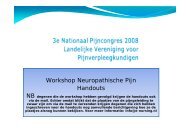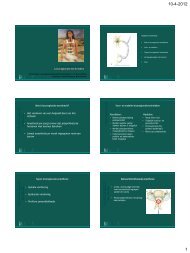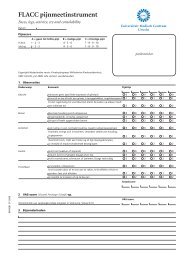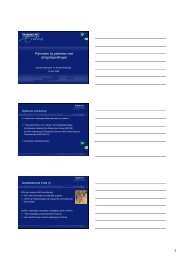Nieuwe invasieve technieken binnen chronische pijnbehandelingen
Nieuwe invasieve technieken binnen chronische pijnbehandelingen
Nieuwe invasieve technieken binnen chronische pijnbehandelingen
Create successful ePaper yourself
Turn your PDF publications into a flip-book with our unique Google optimized e-Paper software.
<strong>Nieuwe</strong> <strong>invasieve</strong> <strong>technieken</strong> <strong>binnen</strong><br />
<strong>chronische</strong> <strong>pijnbehandelingen</strong><br />
6 april 2010<br />
Jan Willem Kallewaard, anesthesioloog-pijnspecialist<br />
Kim Doornenbal, nurse practitioner<br />
Pijncentrum, Ziekenhuis Rijnstate, Arnhem
Ziekenhuis Rijnstate Klinieken Velp<br />
Ziekenhuis en Verpleeghuis<br />
Zevenaar<br />
Alysis locaties<br />
Poli Zuid Poli Dieren
Inhoud<br />
1. Wervelkolom gerelateerde pijn<br />
- Discogeen<br />
- Radiculair<br />
2. Diagnostiek en behandeling radiculaire pijn<br />
- LRS<br />
- ARP<br />
- FBSS<br />
- Behandelalgoritme<br />
3. Invasieve behandelingen Discogene pijn
1. Anatomie wervelkolom<br />
+/- 33 beenderen<br />
- Cervicaal (C1 - C7)<br />
- Thoracaal (T1 - T12)<br />
- Lumbaal (L1 - L5)<br />
- Sacraal (S1 - S5)<br />
- Coccyx (Cc1 – Cc3/4)<br />
Processi dienen als<br />
aanhechtingspunt voor spieren<br />
Massa neemt toe naar onder
1. Anatomie wervelkolom<br />
Spinaal kanaal loopt door “foramen vertebrale”<br />
Discus intervertebralis
1. Anatomie neuro
1. Anatomie natuurlijk verloop<br />
Veroudering wervelkolom:<br />
- Discus<br />
- Facetgewrichten<br />
- Ligamenten en bot<br />
- Anatomisch<br />
- Biochemisch<br />
- Biomechanisch<br />
- Radiologisch (Degeneratie bij 35% van mensen 20 – 39 jr en<br />
vrijwel allemaal bij >60 jr, middels MRI)
1. Anatomie natuurlijk verloop
1. Discusdegeneratie<br />
Natuurlijk Verloop<br />
- Disc degeneration implies a decline of the physical and<br />
chemical properties of the entire anulus fibrosus and nucleus<br />
pulposus or a portion of it, with pathologic changes evident<br />
at the cellular and molecular level.<br />
Holm S. Acta Orthop Scand. Suppl 251: 13-15, 1993
2. Wervelkolom gerelateerde pijn<br />
2.1 Discogeen<br />
2.2 Radiculair<br />
Korte termijn effect: > 3maanden<br />
Lange termijn effect> 6 maanden
2.1 Rugklachten prevalentie NL (RIVM )<br />
Jaarprevalentie van nek- en rugklachten:<br />
- 85,5 per 1.000 mannen en 113,0 per 1.000 vrouwen. (=687.000 mannen en 925.800<br />
vrouwen).<br />
Jaarprevalentie lage-rugpijn met uitstraling<br />
- 13,4 per 1.000 mannen en 16,6 per 1.000 vrouwen.<br />
Jaarprevalentie van HNP<br />
- 3,7 per 1.000 mannen en 2,2 per 1.000 vrouwen.
2.1 Rugklachten indeling<br />
Specifieke rugklachten:<br />
- Rugklachten, specifiek pathofysiologisch mechanisme (HNP,<br />
infectie, ontsteking, osteoporose, fractuur of tumor)<br />
Aspecifieke rugklachten:<br />
- Rugklachten, geen specifieke oorzaak aantoonbaar. Bij<br />
ongeveer 90% van de mensen met rugklachten (Deyo et al.,<br />
1992).
2.1 Rug/been klachten epidemiologie<br />
Chronische rugpijn en “spinal disabilities” 3e meest<br />
voorkomende oorzaak van <strong>chronische</strong> klachten (na cardiale<br />
aandoeningen en arthritis) 1<br />
Ongeveer 5% van de mensen ervaart voor de 1e keer in een<br />
jaar episode van lage rugpijn. In een heel leven ervaart 60–80%<br />
van de mensen een episode van rugpijn 2,3<br />
1. Borestein D. Curr Opin Rheumatol 1991;3:207-17<br />
2. Papageorgiou AC et al. Spine 1995; 20:1889-94<br />
3. Cassidy DJ. Spine 1998;23:1860-7
2.1 Rug/beenpijn etiologie<br />
Degeneratie:<br />
- Discus<br />
- Facetgewrichten<br />
- Ligamenten en bot<br />
Spondylolysis/<br />
spondylolisthesis<br />
Fracture (traumatic or<br />
osteoporotic)<br />
Static abnormalities<br />
e.g. scoliosis<br />
BACK<br />
PAIN<br />
Degenerative changes<br />
intravertebral joints<br />
Spinal stenosis<br />
Chronic rheumatoid<br />
inflammation of the<br />
spinal cord<br />
Many of these conditions may require<br />
surgery, which may result in FBSS
Diagnosis of common conditions leading to low back and/or leg pain<br />
Source of<br />
pain<br />
Disc<br />
degenera<br />
-tion<br />
Disc<br />
herniation<br />
Facet<br />
joint pain<br />
Spinal<br />
stenosis<br />
Key characteristics<br />
1.Predominantly located in the low back area, may<br />
radiate out to gluteal zone(s)<br />
2.May radiate to lower limb(s), in a nondermatome<br />
distribution<br />
3.Increases during activities that increase strain on<br />
the disc, such as sitting, bending or lifting weights<br />
4.Improves when resting or walking around<br />
1.Pain is mostly dermatome-bound and course<br />
corresponds to the spinal nerve innervation<br />
2.Sensory disorders in the affected dermatome<br />
may be described<br />
3.There may be a reduction in the strength of the<br />
muscles associated with the affected nerve<br />
1.Pain usually lateral to the midline, often<br />
accompanied by discogenic back pain<br />
1.Pain usually radiates from the back to the gluteal<br />
zone and lower limbs (‘pseudo-claudication’)<br />
2.Pain generally increases when walking and<br />
standing up for long periods, and improves when<br />
bending; however, riding a test-bike at high workload<br />
is often possible (forward bend), making leg<br />
ischaemia less probable<br />
Clinical examination<br />
1.In most cases lumbar flexion is<br />
restricted and painful<br />
2.Usually low-lumbar pressure<br />
sensitivity<br />
3.No neurological abnormalities or<br />
signs of root compression<br />
1.Demonstrates neurological<br />
abnormalities, such as sensory<br />
disorders, weakened reflexes and<br />
motor weakness<br />
2.The Lasègue test or femoralis test is<br />
usually positive<br />
1.Signs not specific<br />
2.Patients usually feel pain on<br />
extension<br />
3.Often paravertebral elective<br />
pressure pain in the facet joints<br />
1.Signs not specific<br />
2.Medical history usually allows a<br />
diagnosis to be made<br />
Other examinations<br />
1.X-rays usually show narrowing of one or<br />
more intervertebral spaces, osteophyte<br />
growth may be present<br />
2.MRI scans usually show dehydration of<br />
the disc<br />
1.Hernia can be seen on a CT or MRI<br />
scan<br />
2.EMG and meticulous neurological<br />
examination confirms which root is<br />
compressed<br />
1.Radiological images, particularly the ¾rotation<br />
image, can show the facet joint<br />
compression<br />
2.CT scans can show narrowed and<br />
hypertrophic facet joints<br />
3.Infiltration of the joint with local<br />
anaesthetic and a corticoid preparation,<br />
under fluoroscopy or CT support, results<br />
in immediate pain relief<br />
1.Diagnosis suspected if the radiological<br />
images show a degenerative antero-<br />
/laterolisthesis<br />
2.Diagnosis can be confirmed by a CT<br />
scan, by MRI or by myelography
2.2 Radiculair syndroom definitie<br />
Lumbosacraal radiculair syndroom (LRS):<br />
“Radiculaire pijn in één been, al dan niet met andere<br />
prikkelingsverschijnselen en neurologische<br />
uitvalsverschijnselen van de aangedane<br />
lumbosacrale zenuwwortel(s).”<br />
Smeele, 1998
2.2 Geen zenuw compressie?<br />
= geen herniated disc?<br />
= geen radicular pain?<br />
= “pseudo-radicular<br />
pain”??
3.1 Radiculair syndroom oorzaak LRS<br />
Irritatie van of compressie op de zenuwwortel, meestal<br />
door een discushernia
3.1 LRS pathofysiologie<br />
Directe wortel compressie neurologic symtomps<br />
Inflammatoire component, chemische prikkeling (prostaglandine<br />
E2)<br />
nucleus pulposis (zacht, elastisch,<br />
gehydreerd, op
3.1 LRS pathofysiologie HNP
3.1 LRS soorten HNP<br />
Mediaan<br />
Paramediaan<br />
Lateraal
Conservatief<br />
Epiduraal<br />
PRF<br />
Nucleoplasty<br />
Tdd<br />
ozon<br />
Behandelstategie<br />
Operatie
3.1 LRS behandelbeleid<br />
Multidisciplinaire richtlijnen LRS CBO<br />
Conservatief, expectatief<br />
- Operatief ingrijpen<br />
Smeele, 1998<br />
CBO, 1995<br />
CBO, 2008
3. Diagnose en behandeling<br />
3.1 Acuut radiculair syndroom: minder dan 6 weken<br />
klachten ; na 3 maanden 90% spontaan herstel<br />
3.2 Acute Rugpoli<br />
3.3 Behandelalgoritme
3.1 LRS spontaan verloop HNP<br />
Discus weefsel<br />
Epiduraal<br />
Immuun systeem<br />
Neovascularisatie<br />
- Pijn verdwijnt zonder ingreep > 90%<br />
- MRI studies: dehydratie<br />
- Rol macrophagen?<br />
Macrophagen<br />
Prostaglandine E2<br />
IL 1<br />
TNF alpha<br />
proteinases<br />
Discusafbraak<br />
Pijn
Voeding cellen
3.2 Acute rugpoli<br />
Aanleiding:<br />
- LRS patiënten = grote populatie pijnpoli<br />
- Geen eenduidig verwijsbeleid<br />
- “Vertroebeling” van de patiëntenstroom<br />
- Onvoldoende informatievoorziening patiënten<br />
Doel:<br />
- Zorgpad voor patiënten met een acuut lumbosacraal radiculair<br />
syndroom<br />
- voldaan informatieplicht en juiste filtering van patiënten<br />
- De effectiviteit, continuïteit en de kwaliteit van zorg voor deze<br />
patiëntengroep is gewaarborgd<br />
- Toename patienttevredenheid
3.2 Acute rugpoli behandeltraject HNP<br />
Anaesthesiologisch Traject Chirurgisch Traject Conservatief Traject<br />
Selectieve Wortelblokkades<br />
Intradiscaal traject<br />
Tevreden Niet tevreden<br />
Anaesthesiologisch /<br />
Orthopedisch Spreekuur<br />
Scopisch Mini open<br />
Niet tevreden Tevreden<br />
Gesprek<br />
Re-activatie<br />
Van Susante juni 2004
4.1 Epidurale corticosteroiden<br />
169 patients<br />
JBJS 2004;86A(4):670-679<br />
HNP >25% cross-sectional area spinal canal<br />
minimum 6 wks non-invasive treatment<br />
epidural steroid injection vs. discectomy
4.1 Epidurale cortico’s resultaten
4.1 Epidurale cortico’s conclusie<br />
Both effective treatments<br />
Discectomy > steroid injection (large HNP)<br />
Delaying surgical treatment no adverse effect, only delayed<br />
(equal) recovery<br />
Strong evidence short term effect
4.1 Zenuwblokkade, PRF<br />
Epidurale corticosteroiden<br />
Transforaminale lumbale epidurale infiltratie: sterke evidence<br />
korte termijn effecten<br />
Midline lumbale epidurale infiltratie: geen evidence<br />
Pulsed Rf dorsale root ganglion<br />
positieve prospectieve studies, nog geen RCT<br />
1 postieve RCT Cervical Pulsed RF. (van Zundert, 2007)
4.3 Intradiscale behandeling voor HNP<br />
4.3.1. Nucleoplastiek<br />
4.3.2 TDD<br />
4.3.3 Ozon
4.3.2 Nucleoplasty techniek<br />
Total of 6-8 channels created by activating coblation generator<br />
water drop shaped ablation of nucleus is created by rotating the<br />
S shaped tip<br />
0.2-0.5 cc tissue removed<br />
Result of Nucleoplasty
4.3.2 Nucleoplasty Coblatie®<br />
Low frequency, high current RF<br />
Bipolar configuration<br />
Luminous plasma field in aqueous environment<br />
Minimal thermal penetration<br />
- cell death (
4.3.2 Nucleoplasty onderzoek temp<br />
Change in<br />
Temperature (ºC)<br />
20<br />
15<br />
10<br />
5<br />
0<br />
Porcine Intradiscal Thermal Mapping<br />
Temperature Gradient<br />
1 2 3 4 5<br />
Distance from tip (mm)<br />
Chen YC, Lee SH, Chen D, Saenz Y. Presented at the ISIS annual meeting, Boston, MA,<br />
2001; NASS Meeting of the Americas, NY, NY, April 2002.
4.3.2 Nucleoplasty onderzoek druk<br />
PSI<br />
30<br />
25<br />
20<br />
15<br />
10<br />
5<br />
0<br />
Nucleoplasty Intradiscal Pressure<br />
Non-Severe Degeneration<br />
0 1 2 3 4 5 6<br />
Number of Channels<br />
Chen YC, Lee SH, Chen D. Spine 2003;28:661-665.<br />
Nucleo PSI<br />
Control PSI
4.3.2 Nucleoplasty onderzoek Disc<br />
Biochemistry<br />
Authors suggested:<br />
Altered cytokine expression<br />
consistent with mechanism<br />
of pain relief<br />
Plasma discectomy capable<br />
of initiating a repair response<br />
Concentration<br />
16<br />
14<br />
12<br />
10<br />
8<br />
6<br />
4<br />
2<br />
0<br />
Baseline 6 Weeks 12 Weeks<br />
IL-1 Degenerative Trend IL-1 Nucleoplasty Impact<br />
IL-8 Degenerative Trend IL-8 Nucleoplasty Impact<br />
O’Neill et al, Percutaneous plasma decompression alters cytokine expression in injured<br />
porcine vertebral discs. The Spine Journal 2004;4:88-98.
4.3.2 Nucleoplasty klinisch onderzoek<br />
Natural history (2 years) of pain reduction in patients (n=16) with radicular pain<br />
treated for contained, herniated disc<br />
10<br />
9<br />
VAS<br />
8<br />
7<br />
6<br />
25th Q<br />
5<br />
Median<br />
4<br />
75th Q<br />
3<br />
2<br />
1<br />
0<br />
Preop 1 Mo. 3 Mo. 6 Mo. 12 Mo. 18 Mo. 24 Mo.<br />
Sharps Spine J 2004.
4.3.2 Nucleoplasty case-series<br />
No RCTs for lumbar region ( 1 positive RCT cervical)<br />
Overall: Better for sciatica, maybe also axial back<br />
pain<br />
Own results with strict selection criteria: 85% succes<br />
(> 50% VAS reduction)<br />
With liberal selection criteria: < 50 % succes
4.3.3 Targeted Disc Decompression<br />
Shrinkage tissue = side effect of IDET = goal of TDD<br />
Possible in relatively dehydrated nucleus<br />
Temperature penetration further from probe
4.3.3 TDD<br />
Schaufele 2005: case series n=22<br />
- back pain -2.8 points<br />
- leg pain -3.5 points<br />
- SF 36 bodily pain score +35.8 points
4.3.4 Ozone<br />
O2-O3 mixture<br />
Intradiscal: oxydative<br />
dehydration<br />
Epidural/peri ganglionic:<br />
oxydative stress causes<br />
upregulation anti oxydative,<br />
anti inflammatory intra<br />
cellulair mechanisms<br />
Anti inflammatory and direct<br />
analgesic
4.3.4 Ozone mechanisme<br />
O3 degrades rapidly and leads to the formation of an extremely<br />
complex and heterogeneous cascade of compounds: reactive<br />
oxygen species (ROS), including “ free radicals”<br />
H 2 O 2 increase dose related to O3 levels<br />
Oxydative stress causes upregulation of anti-oxydative, antiinflammatory<br />
intracellular mechanisms by gene expression
4.3.4 Ozone research<br />
Case series<br />
Muto 2004:<br />
case series n=2200<br />
- 6 month 80% success n=1750<br />
Paradiso 2005:<br />
O3 >Microdiscectomy for contained<br />
discsherniation<br />
Buric 2005: 12 month 90% pain<br />
improvement, non-contained<br />
Alexandre 2005; cervical, “impressive,<br />
dramatic”<br />
RCT<br />
Bonetti 2005: RCT O3 vs steroids<br />
intraforaminal:<br />
- Success overall=“excellent”<br />
- 1 month 95 (85) % vs 92<br />
(80)%<br />
- 6 months 84 (75) % vs 77<br />
(57)%<br />
Galluci 2007: RCT steroids & O3 vs<br />
steroids. Both intraforaminal and<br />
intradiscal:<br />
- Success overall “excellent”<br />
- 6 months results: 74 % vs<br />
47 %
4.3.4 Ozone voor/nadelen<br />
Voordelen<br />
Veilig, anti-septisch<br />
Goedkoop<br />
Interessante resultaten in DDD<br />
zondersciatica<br />
Positieve RCTs<br />
Aanbevelingen:<br />
Pre klinische studies<br />
Dose finding studies<br />
RCTs<br />
Nadelen<br />
Brede variatie in methode en<br />
dosis ozone<br />
Intradiscale dosis 2.10 ml!<br />
Steroiden als co-medicatie<br />
Indicaties?<br />
Associatie met alternatieve<br />
geneeskunde
Kleine contained<br />
protrusie:<br />
- Lage respons<br />
discectomie en<br />
conservatieve<br />
therapie<br />
Behandel dillema’s
Nieuw behandelalgoritme?<br />
Vroegtijdige transforaminale epidurale injectie steroïden<br />
Redo 1 á 2x<br />
Geen pijnreductie of persisterende pijn na weken:<br />
- Contained hernia, geen black disc, Nucleoplasty<br />
- Misschien contained, black disc TDD<br />
- Geen contained (kleine) hernia Ozone<br />
- Grote hernia/ zenuw compressie Discectomie
Groote extruded<br />
herniated discs:<br />
Goede resultaten:<br />
- Discectomy<br />
Behandel dilemmas<br />
- conservatieve<br />
behandeling
3.3 FBSS /<strong>chronische</strong> radiculaire pijn<br />
syndroom of “gewoon” een<br />
benaming?<br />
“Terugkerende persisterende pijn, meestal in de regio<br />
van de onderrug en benen, na technisch, anatomisch<br />
succesvolle lumbosacrale rugchirurgie(s)” 1<br />
10-40% van de rugchirurgie patienten<br />
1. Leveque JC et al. Neuromodulation 2001; 4 (1):1-19<br />
2. Stojanovre MP Curr Pain Head Rep 2001; 54: 130-7<br />
3. North RB et al. Neurosurgery 2005; 56: 98-107<br />
2, 3
3.3 FBSS Klinische presentatie<br />
FBSS:<br />
Vermindering van klachten na operatie<br />
Recidief klachten 6-12 weken post OK (epidurale fibrose)<br />
<strong>Nieuwe</strong> klacht:<br />
Patiënt heeft jaren geen klachten gehad, jaren later zelfde<br />
symptomen<br />
- Continue<br />
- brandend, jeukend type pijn<br />
- Hypo-esthesie<br />
- Allodynie<br />
- Paresthesieën
3.3 FBSS oorzaken/symptomen<br />
Oorzaken FBSS: 1-5<br />
- Irreversibele zenuwschade<br />
- Recidief hernia (geopereerd of ander niveau)<br />
- Incorrecte diagnose tijdens operatie<br />
- Verkeerde operatieniveau<br />
- Chirurgische complicaties (zenuwbeschadiging of – ontsteking)<br />
- Psychosociale problematiek<br />
- verkeerde patiënt selectie<br />
Symptomen FBSS patienten: 3,4,6<br />
– Lumbosacrale postoperatieve fibrosen/of arachnoiditis<br />
– Zenuw leasie<br />
– dorsale compartiment syndroom<br />
– Laterale spinaal stenose<br />
1. Anderson VC et al. Current review of pain 2000;4:105-11 5. Vaccaro AR et al. Spine 2001;26 (24): S111-8<br />
2. Leveque JC et al. Neuromodulation 2001;4:1-9 6. . Long DM. Surgical management of pain 2002: 354-64<br />
3. Dario A et al. Neuromodulation 2001;4:105-110<br />
4. Ohnmeiss DD et al. The Spine Journal 2001:358-363
3.4 Behandel algoritme<br />
Gedragstherapie (overgewicht, depressie, alcohol, drugs afhankelijkheid)<br />
Conservatieve therapie<br />
- Medicamenteus/ Coanalgetica<br />
- Revalidatie, fysiotherapie, sychologische hulp<br />
- Transcutane Elektrische Neuron Stimulatie (TENS)<br />
Invasieve behandelingen<br />
- Percutane zenuwblokkades, epidurale injecties, PRF<br />
- Neuroplasty ( RACZ)<br />
- Epiduroscopie<br />
- Neuromodulatie (50-75% verbetering, toename QoL, afname med gebruik, afname<br />
been VAS)<br />
- ITDD/ITB<br />
Percutane en chirurgische ingrepen
3.4 Algoritme pijnbestrijding<br />
Intrathecale medicatie<br />
Ruggenmergstimulatie, neurostimulatie, adhesiolyse,<br />
epiduroscopie<br />
Stap III: Sterke opioïde en co-analgetica<br />
Stap II: Zwakke opioïde en co-analgetica<br />
Infiltratie (subacute), radiofrequentie (chronisch)<br />
Stap I: niet opioïde (perifere) analgetica en co-analgetica<br />
Permanente diagnose en behandeling met psychologische begeleiding en ondersteuning,<br />
fysiotherapie, revalidatie.<br />
54
4. Invasieve behandelingen<br />
4.1 Percutane zenuwblokkades, epidurale injecties, PRF<br />
4.2 Neuroplasty ( RACZ)<br />
4.3 Intradiscale behandelingen<br />
- Discografie<br />
- Nucleoplasty<br />
- TDD/IDET<br />
- Ozon discolyse<br />
4.4 Epiduroscopie<br />
4.5 Neuromodulatie<br />
4.6 ITDD/ITB
4.2 RACZ<br />
Primary object: target drug delivery to areas of<br />
pathology in the epidural space.<br />
Removing barriers, such as epidural fibrosis, that<br />
prevent drugs from reaching target sides.<br />
sedatie<br />
Short term effect ( 3 month) : strong evidence<br />
Long term effect ( > 3 month): moderate evidence
4.3.1 Discografie<br />
Doel:verband aantonen tussen gevonden afwijkingen<br />
en de pijn. Contained of niet contained HNP?<br />
Drukmeting<br />
Pt krijgt sedatie, disci worden aangeprikt. Pt geeft<br />
aan of provocatief is en herkenbaar.<br />
Risico’s:<br />
- X (zwangerschap)<br />
- Vals positief of vals negatieve uitslag<br />
- Spondylodiscitis<br />
- Zenuwbeschadiging<br />
- Allergie contrastvloeistof
4.4 Epiduroscopie<br />
Indicatie:<br />
- Diagnostisch of therapeutisch<br />
- Lumbosacrale segmentale pijn<br />
Doel<br />
- Zenuwcompressie<br />
- Radiculitis<br />
- Epidurale fibrosis<br />
- Spinale stenose<br />
- Adhaesiolyse van de wortels<br />
- Lavage<br />
- Doelgericht medicatie achterlaten
4.4 Epiduroscopie inclusie criteria<br />
Radiculaire pijn in 1 of 2 segmenten<br />
Beenpijn> rugpijn<br />
VAS > 5<br />
Positieve zenuwwortel prikkelingsverschijnselen<br />
Neurologische uitvalsverschijnselen<br />
Klachten > 3 maanden<br />
Conservatief behandeld<br />
Voorgeschiedenis bekend<br />
MRI < 6 maanden met littekenweefsel
4.4Epiduroscopie onderzoek<br />
Strong evidence short and long term effect of spinal<br />
endoscopy in radicular pain<br />
Moderate effect in spinal stenosis (2007)
BMC Anesthesiology 2005
4,4 Epiduroscopie developments 2009<br />
Resascope<br />
4 richtingen<br />
Extra lumen<br />
Adhesiolyse met tools ( foggerty/resaflex)
4.4 Epiduroscopie complicaties<br />
Infectie<br />
Epiduraal hematoom<br />
Visusstoornissen, retinabloeding<br />
Zenuwwortel beschadiging<br />
Duraperforatie PSH<br />
Onbedoelde intrathecaal injecteren<br />
Toename bestaande pijnklachten<br />
Pijn bij stuitje
4.5 Neuromodulatie<br />
Neuromodulation: level 1 evidence positive effect<br />
1. Transcutaneous electrical<br />
nerve stimulation (TENS)<br />
2. Peripheral nerve<br />
stimulation<br />
3. Spinal cord stimulation<br />
(dorsal columns)<br />
4. Deep brain stimulation<br />
(sensory thalamus, PVG or<br />
other structures)<br />
5. Motor cortex stimulation<br />
5
4.5 Neuromodulatie deelgebieden<br />
Neuromodulatie is door middel van elektriciteit en/of stoffen (medicijnen) de werking<br />
van het zenuwstelsel beïnvloeden, waardoor het zenuwstelsel verandert, met<br />
een therapeutisch effect als gevolg.<br />
Neuromodulatie<br />
neuropatisch nociceptief<br />
Elektrische stimulatie<br />
TENS<br />
Neurostimulatie<br />
Farmaca<br />
Intrathecale<br />
toediening<br />
65
4.5 Neurostimulatie indicaties<br />
Neurostimulatie<br />
FBSS<br />
Perifeer Vaatlijden<br />
Angina Pectoris<br />
CRPS<br />
Arachnoiditis<br />
Radiculopathieën<br />
Neurostimulatie/<br />
Intrathecale therapie<br />
FBSS<br />
CRPS<br />
Arachnoiditis<br />
Neuropathieën<br />
Ruggenmergletsel<br />
Herpes Zoster<br />
Intrathecale therapie<br />
Diffuse Kanker Pijn<br />
Osteoporose<br />
Viscerale Pijn<br />
66
4.5 SCS werkingsmechanisme<br />
De electrische pulsen activeren de<br />
pijninhiberende neuronale<br />
circuits in de achterhoorn en<br />
geven paresthesieën welke de<br />
pijnsensatie maskeren.<br />
Linderoth and Meyerson. The neurobiology of pain 1995<br />
67
4.6 ITDD<br />
IntraThecaal Drug Delivery (ITDD)<br />
Pijn Spasticiteit<br />
Combinatie<br />
therapie<br />
71
4.6 ITDD<br />
IntraThecale Drug Delivery (ITDD)<br />
of<br />
Spinal Admision of Narcotics (SAN)<br />
Intrathecale toediening van medicatie<br />
Modulatie van de pijnsensatie<br />
Niet destructief, omkeerbaar<br />
72
Specifieke(Discogene) lage rugpijn<br />
Algoritme<br />
Anamnese/lichamelijk onderzoek<br />
Conservatief/medicamenteus/TENS<br />
Proef/RF Facet<br />
Discografie<br />
RF-Ramus communicans<br />
Intradiscale behandeling?<br />
OK?
Specifieke lage rugklachten<br />
Multifactorieel<br />
45% Facetten<br />
32% SI<br />
35% discus<br />
30% myoligamentair
Discopathie<br />
Normaal<br />
sclerose <br />
Discushoogte verlies
Discopathie<br />
Relatief normaal<br />
normaal<br />
Waterverlies in disci (lager signaal tov normaal<br />
Uitgebreide discusdegeneratie L5/S1
HIZ and discogenic pain<br />
Prevalence in normal<br />
controls: 24%<br />
Prevalence in low back pain<br />
patients: 59%<br />
Hiz: chemical, inflammatory<br />
sensitization of annular<br />
nociceptors ( Derby)<br />
Carragee E. Spine 2000;25: 2789-92
Discografie ( gouden standaard)<br />
Discografie=disc-manometrie<br />
Gecontroleerde procedure<br />
Controleert: vloeistofsnelheid<br />
Calibreert voor viscositeit<br />
Calibreert needle gauge<br />
Gecontroleerde manometrie
Discografie ( ISIS/IASP)<br />
Exacte pijn reproductie VAS>6<br />
Negatieve controle discus<br />
Pos discus bij
4.3.1 Discografie provocatief?<br />
Technique
4.3.1 Discografie doel<br />
Diagnostisch: discogene pijn?<br />
Prognostisch?<br />
- Niveau?<br />
- Succes OK?
Intradiscale behandeling ( evidence)<br />
RF-Discus: 2x negatieve RCT (-)<br />
IDET: 1 positieve en 1 negatieve RCT ( 2B+)<br />
Disctrode: 1 neg RCT ( -)<br />
Biaccuplasty: 1 pos prospective studie ( 2C+)<br />
Ozon: geen studies<br />
Methylene Blue: 1 POS RCT ( 2A+)
Bedankt!<br />
kdoornenbal@alysis.nl<br />
jkallewaard@alysis.nl







